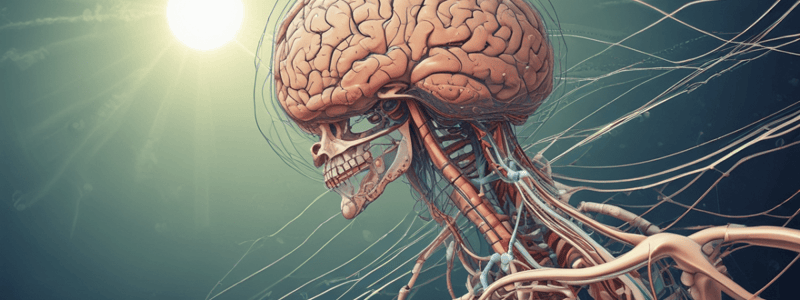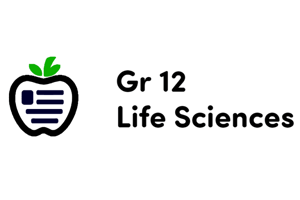Podcast
Questions and Answers
Which region of the brain contains the cerebral cortex, thalamus, hypothalamus, pineal gland, and limbic system?
Which region of the brain contains the cerebral cortex, thalamus, hypothalamus, pineal gland, and limbic system?
Which part of the central nervous system is where the brain transitions to the spinal cord?
Which part of the central nervous system is where the brain transitions to the spinal cord?
What connects the right and left cerebral hemispheres in the brain?
What connects the right and left cerebral hemispheres in the brain?
Which part of the central nervous system contains the respiratory and cardiovascular control centres?
Which part of the central nervous system contains the respiratory and cardiovascular control centres?
Signup and view all the answers
In which lobes is the cerebral cortex divided into?
In which lobes is the cerebral cortex divided into?
Signup and view all the answers
Which part of the central nervous system includes the brainstem and cerebellum?
Which part of the central nervous system includes the brainstem and cerebellum?
Signup and view all the answers
What is the main function of the limbic system?
What is the main function of the limbic system?
Signup and view all the answers
Which part of the brain is involved in controlling habit learning and cognition?
Which part of the brain is involved in controlling habit learning and cognition?
Signup and view all the answers
What function does the cerebellum perform?
What function does the cerebellum perform?
Signup and view all the answers
Which brain structure connects the forebrain to the spinal cord?
Which brain structure connects the forebrain to the spinal cord?
Signup and view all the answers
What is the main function of the brainstem?
What is the main function of the brainstem?
Signup and view all the answers
What is the role of the spinal cord in the central nervous system?
What is the role of the spinal cord in the central nervous system?
Signup and view all the answers
What is the composition of the white matter in the spinal cord?
What is the composition of the white matter in the spinal cord?
Signup and view all the answers
Which statement accurately describes the decussation of sensory pathways?
Which statement accurately describes the decussation of sensory pathways?
Signup and view all the answers
Where is the perception of motor pathway located in the brain?
Where is the perception of motor pathway located in the brain?
Signup and view all the answers
In which hemisphere does the right cerebral cortex control body movements?
In which hemisphere does the right cerebral cortex control body movements?
Signup and view all the answers
What type of nerves are formed when spinal nerves coalesce?
What type of nerves are formed when spinal nerves coalesce?
Signup and view all the answers
Which part of the brain receives sensory information from the opposite side of the body?
Which part of the brain receives sensory information from the opposite side of the body?
Signup and view all the answers
What is the main function of the autonomic nervous system (ANS)?
What is the main function of the autonomic nervous system (ANS)?
Signup and view all the answers
Which division of the autonomic nervous system is responsible for the 'fight or flight' response?
Which division of the autonomic nervous system is responsible for the 'fight or flight' response?
Signup and view all the answers
What regions of the body do parasympathetic nerves supply?
What regions of the body do parasympathetic nerves supply?
Signup and view all the answers
In the context provided, what do the sensory fibres primarily do?
In the context provided, what do the sensory fibres primarily do?
Signup and view all the answers
Why is it important to know the anatomy of the brain and its pathways?
Why is it important to know the anatomy of the brain and its pathways?
Signup and view all the answers
What is the primary function of the parietal lobe?
What is the primary function of the parietal lobe?
Signup and view all the answers
Which region of the brain is mainly responsible for processing sensory information and plays a crucial role in hearing and memory formation?
Which region of the brain is mainly responsible for processing sensory information and plays a crucial role in hearing and memory formation?
Signup and view all the answers
What is the major function of the hypothalamus in the brain?
What is the major function of the hypothalamus in the brain?
Signup and view all the answers
Which lobe of the brain is primarily associated with higher executive functions like planning, reasoning, and problem-solving?
Which lobe of the brain is primarily associated with higher executive functions like planning, reasoning, and problem-solving?
Signup and view all the answers
What does the pineal gland primarily produce?
What does the pineal gland primarily produce?
Signup and view all the answers
Which forebrain region in the brain is associated with processing sensory information?
Which forebrain region in the brain is associated with processing sensory information?
Signup and view all the answers
Study Notes
The Brain
- The brain has several regions, each with specific functions, and are linked to allow maximum functional integration.
- The brain is built layer by layer, with the most complex functions being controlled at the highest levels.
Lateralization of Brain Function
- The left and right cerebral hemispheres control the opposite sides of the body.
- Sensory pathways decussate (cross-over) from one side of the CNS to the other.
- Motor pathways decussate from one side of the CNS to the other.
Lobes of the Cortex
- Frontal lobe: responsible for higher executive functions, including emotional regulation, planning, reasoning, and problem-solving.
- Parietal lobe: responsible for integrating sensory information, including touch, temperature, pressure, and pain.
- Temporal lobe: responsible for processing sensory information, particularly important for hearing, recognizing language, and forming memories.
- Occipital lobe: the major visual processing center in the brain.
Forebrain Regions
- Thalamus: processes sensory information.
- Hypothalamus: the major control center of the autonomic motor system, involved in hormonal activity, and regulates homeostasis.
- Pineal gland: produces the hormone melatonin, regulating sleep-wake cycles.
Spinal Cord
- Composed of grey matter and white matter.
- White matter is composed of fibre tracts of myelinated sensory and motor axons.
- Knowledge of tract locations and functions allows localization of damage.
Cranial Nerves and Spinal Nerves
- Cranial nerves: 12 pairs, responsible for transmitting information to and from the brain.
- Spinal nerves: 31 pairs, emerging from the spinal cord, controlling various functions and sensations.
Autonomic Nervous System
- Functions without conscious control to maintain homeostasis.
- Divided into sympathetic (fight or flight) and parasympathetic (rest and digest) systems.
- Controls cardiac muscle, smooth muscle, exocrine glands, and endocrine glands.
Central Nervous System
- Consists of the brain and spinal cord.
- The peripheral nervous system is made up of cranial nerves and spinal nerves.
Brain Structure
- The forebrain is the largest region, containing the cerebral cortex, thalamus, hypothalamus, pineal gland, and limbic system.
- The hindbrain includes the brainstem and cerebellum.
- The brainstem connects the forebrain to the spinal cord and cerebellum.
Cerebral Cortex
- Divided into right and left cerebral hemispheres, connected by the corpus callosum.
- Each hemisphere is divided into four lobes: frontal, parietal, temporal, and occipital.
Cerebellum
- Coordinates gait, maintains posture, controls muscle tone, and voluntary muscle activity.
- Receives information from the cerebral cortex and muscles, tendons, and joints.
Brainstem
- Connects the forebrain to the spinal cord and cerebellum.
- Responsible for many vital functions, including breathing, consciousness, blood pressure, heart rate, and sleep.
Studying That Suits You
Use AI to generate personalized quizzes and flashcards to suit your learning preferences.
Related Documents
Description
Test your knowledge on the structure and arrangement of the central nervous system, including the brain and spinal cord. Explore topics such as the forebrain and other regions of the brain. This quiz is based on content from Paul Austin School of Medical Sciences and The University of Sydney.




